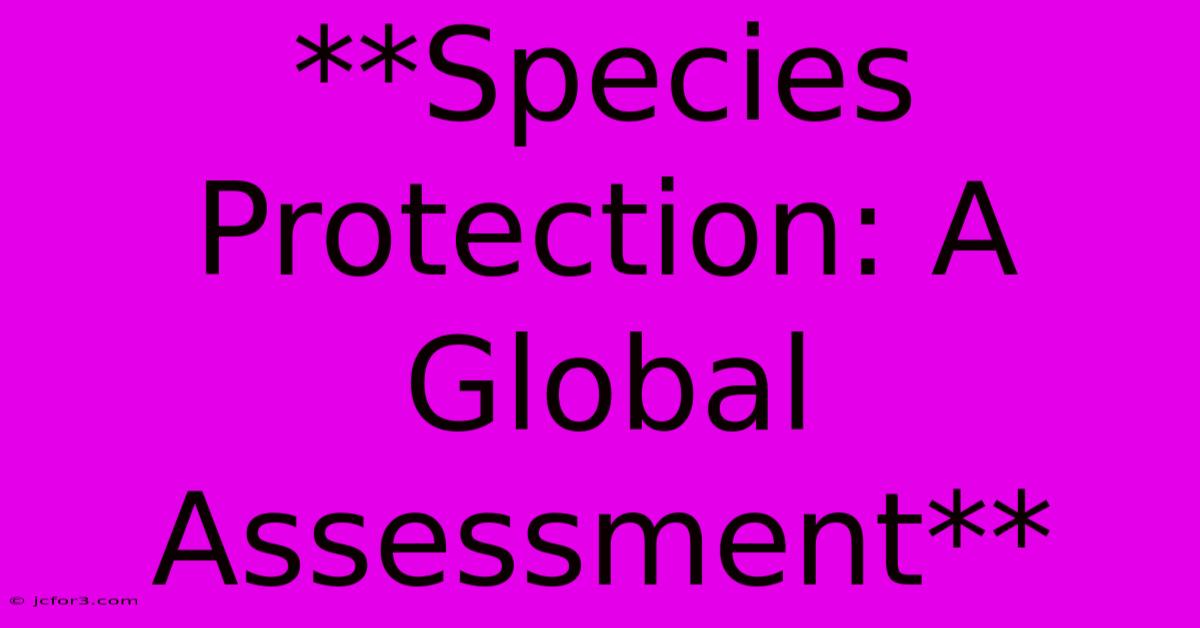**Species Protection: A Global Assessment**

Discover more detailed and exciting information on our website. Click the link below to start your adventure: Visit Best Website mr.cleine.com. Don't miss out!
Table of Contents
Species Protection: A Global Assessment
The Earth's biodiversity is facing an unprecedented crisis. Species extinction rates are accelerating, driven by human activities like habitat loss, climate change, and pollution. This presents a critical challenge to the well-being of our planet and its inhabitants. Protecting species is not just an environmental concern, it's a crucial step towards ensuring a sustainable future for all.
The State of Species Protection
While international agreements like the Convention on Biological Diversity (CBD) strive to safeguard biodiversity, the reality paints a bleak picture.
- IUCN Red List: The International Union for Conservation of Nature (IUCN) Red List, a global standard for assessing the conservation status of species, reveals a concerning trend. Over 41,000 species are currently assessed as threatened with extinction, encompassing a significant portion of the world's flora and fauna.
- Habitat Loss: Human activities like deforestation, urbanization, and agricultural expansion continue to destroy natural habitats at alarming rates. This is a primary driver of species extinction, leaving countless animals and plants without the necessary resources for survival.
- Climate Change: The escalating effects of climate change, including extreme weather events, rising sea levels, and shifting ecosystems, are putting immense pressure on vulnerable species. Their ability to adapt and survive in a rapidly changing environment is severely compromised.
- Pollution: Air, water, and soil pollution from industrial processes, agricultural runoff, and plastic waste threaten species directly and indirectly. Pollutants disrupt ecosystems, contaminate food sources, and can cause severe health problems for wildlife.
Key Strategies for Species Protection
Despite the challenges, there are numerous strategies we can implement to mitigate the biodiversity crisis and protect endangered species.
1. Strengthening Legal Frameworks:
- Enforce Existing Laws: Countries must strengthen and enforce existing conservation laws to protect threatened species and their habitats. This includes measures like establishing protected areas, managing hunting and fishing quotas, and controlling illegal wildlife trade.
- Develop New Regulations: New regulations targeting specific threats like invasive species, pollution, and climate change are crucial. These regulations should be scientifically driven and adaptable to evolving challenges.
2. Promoting Sustainable Practices:
- Conservation Agriculture: Transitioning to sustainable agricultural practices like agroforestry and integrated pest management can minimize habitat loss and pollution, benefiting both biodiversity and human livelihoods.
- Responsible Consumption: Consumers can play a vital role by choosing products from sustainable sources and reducing their consumption of goods that contribute to environmental degradation.
3. Investing in Research and Conservation:
- Scientific Understanding: Continued research is essential to understand the ecological needs of threatened species and develop effective conservation strategies. This includes studying population dynamics, habitat requirements, and threats like disease outbreaks.
- Conservation Action: Funding for on-the-ground conservation efforts is crucial. This includes habitat restoration, captive breeding programs, and community-based conservation initiatives.
4. Engaging the Public:
- Raising Awareness: Raising public awareness about the importance of biodiversity conservation is vital. This can be achieved through educational campaigns, documentaries, and citizen science initiatives.
- Empowering Communities: Involving local communities in conservation efforts is crucial. By providing them with the necessary resources and training, we can empower them to become active stewards of their environment.
The Importance of Collective Action
Species protection is a global responsibility that requires collaboration across governments, organizations, and individuals. By working together, we can reverse the alarming trends of biodiversity loss and ensure a future where humans and nature can coexist sustainably.
This is not a task to be taken lightly. The survival of countless species, and ultimately, the health of our planet, depends on our commitment to effective species protection.

Thank you for visiting our website wich cover about **Species Protection: A Global Assessment** . We hope the information provided has been useful to you. Feel free to contact us if you have any questions or need further assistance. See you next time and dont miss to bookmark.
Featured Posts
-
Philipp Kurashev Surnumeraire In Der Nhl Wie Bei Der Wm
Oct 24, 2024
-
Unfall Verletzter Motorradfahrer 75 Fluechtet
Oct 24, 2024
-
Trump Rogan Podcast Ahead Of Election Day
Oct 24, 2024
-
Wm Star Kurashev Surnumeraire In Der Nhl
Oct 24, 2024
-
Ferrari F80 1 200 Ps Aerodynamik Meisterwerk
Oct 24, 2024
